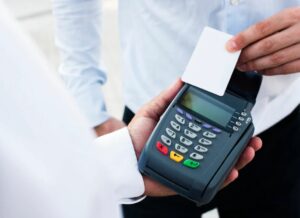Have you ever inspected a bank or credit union’s checking account? If you have either of these two, a monthly statement with the account’s opening and closing amounts will be sent to you. All of the monthly transactions or debts are also included.
Additionally, a transaction type with the designation POS may be found. What does POS in banking entail then?
Pioneers of the Point-of-Sale (POS) Terminal
The National Cash Register (NCR), a corporation that is in charge of the vast majority of cash registers in use today, created the first point-of-sale system. The company transformed manual cash registers into mobile selling systems by integrating new technology, such as bar codes and scanners created in the 1980s.
In recent years, Square, Inc. has led the way in the PoS industry. It launched gear and software “to transform the checkout process and advance digital and mobile commerce by untethering sales from long lines and antiquated cash registers,” the business stated in its Form S-1 filing.
Because of its systems’ direct link with payment card networks, it relieves merchants of the responsibility of upholding industry compliance standards. Another appealing element of the company’s POS systems is business analytics. Even though Square may have been the innovator, there are many other players in this market, which has relatively low entry hurdles.
Please read: DIGITIZING GOVERNMENT PAYMENTS GLOBALLY
What Is a Point-of-Sale Terminal?
A point-of-sale (POS) terminal is a piece of hardware used in retail establishments to handle card payments. Hardware includes inbuilt software for reading magnetic strips on credit and debit cards.
The next generation of point-of-sale (POS) systems will consist of portable (as opposed to counter-anchored) proprietary or third-party devices with contactless capabilities.
How does Point-of-Sale Terminal work?
A traditional point-of-sale (POS) terminal reads the magnetic strip of a credit card or debit card when it is used to purchase to determine whether there is enough money to send to the merchant and then actually makes the transfer. A receipt is printed or provided to the customer through email or text after the sale transaction has been recorded. Depending on how they wish to manage their cash flows, retailers can either purchase or lease a POS terminal.
While leasing equalizes monthly payments compared to buying a system outright, overall lease payments may exceed a one-time purchase throughout the equipment’s useful life.
A tablet or other mobile device can be used to load software-based point of sale (POS) systems, which are the current trend instead of using traditional proprietary hardware. POS terminal manufacturers are releasing their variations of portable and mobile POS terminals to keep ahead of the curve.
These gadgets are common in crowded restaurants and retail establishments whose owners are aware that most patrons dislike having to wait when purchasing a meal or a product. For buyers of POS systems, price, functionality, and user-friendliness are crucial considerations. The security of the systems is crucial in a society that is becoming increasingly interconnected. Customers’ data has been compromised in certain high-profile cases using POS machines with outdated operating systems.
What distinguishes debit from point of sale?
Any purchase made using an ATM card or a debit card with an access device, whether authorized with a PIN or a signature, is considered a POS transaction.
Debit card transactions, on the other hand, can include POS debit card transactions as well as purchase transactions with signature authentication that are moved via national credit card networks.
The introduction of sophisticated POS systems that may assist retailers in tracking and reconciling credit card transactions is a result of the decline in cash transactions following COVID-19 and the need to assess product demand.
How is a POS transaction reconciled?
Following a definition of “What Does POS Mean in Banking? to make sure that your financial activity is recorded accurately and that the amounts are accounted for, we’ll talk about one of the duties that every shop and customer should perform: POS reconciliation.
A POS reconciliation examines two sets of records to determine whether the numbers are consistent. In other words, it verifies that the balance in the account matches the amount that was spent or received. Retail companies and customers can improve the quality and consistency of their financial records by doing POS reconciliation.
To reconcile your POS transaction, follow these 5 steps:
- Compare your statements to internal records.
- Determine which transactions you are unable to cross-reference.
- Check the incoming money on both documents.
- For any issues, get in touch with your bank.
- Keep a well-balanced library
Conclusion
Now that you understand “What does POS in banking mean?”You could want to make more use of it and follow current POS market trends globally.
The advantages of implementing POS for your company, and for merchants, are as follows:
- Accept any amount of transactions with MasterCard and VISA.
- Real-time transaction confirmation
- Print transaction receipts so you can trace POS transactions with a barcode scanner.
- Reduce the price and dangers of handling cash
- With eCommerce POS integration, you can centralize both in-person and online payment transactions.
- The creation of reports for POS reconciliation
Customers find this way of payment to be considerably faster and more convenient than using cash, checks, or POS cash withdrawals.
It’s a secure system, and you can easily match up your POS transactions with bank statements. If there are any transactions that you don’t recognize, you should contact your bank to have them look into it. Go cashless and make use of the POS system’s features, which will help you keep track of all your expenditures.





